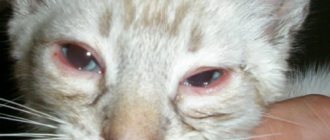(Be the first to vote!)
5589564
08/03/2021 owner reviews
Most cats hate bathing and any activity related to water. Why? Cats are tiny majestic creatures that love to stay clean all the time. Although there are exceptions, most of them don't need baths because they still spend hours upon hours grooming themselves with their tongue.
Even though they can reach most parts of their body with their tongue, there is one part that they cannot reach no matter what - the eyes. And then your furry friend will come to you for help.
Your cat has amazingly beautiful eyes. A little eye discharge is normal for small kittens or even cats, but sometimes their eyes can become runny or watery, forming a crust. If you experience similar symptoms, you should definitely worry.
Learn a few of these tricks to help you keep your cat's majestic eyes clear.
- How to clean cat eyes?
- Causes of discharge from a cat's eye
- Additional Tips
- Finally
How to clean cat eyes?
- Method 1: Warm washcloth
This is more like daily cat eye care at home. All you need is a small soft washcloth and sterilized or boiled water at room temperature. Dip a corner of the cloth into clean water and gently wash away dirt and dust from your cat's eyes and surrounding areas. It is advisable to start from the inner corner of the eye to wipe outwards. Repeat this step carefully to clean your cat's eyes regularly.
© shutterstock
- Method 2: Cotton balls and sterilized water
If you notice that your cat's eyes are dirty and crusty, you can try this method. First of all, wash your hands before and after this procedure. Pour clean water into 2 different bowls (one may be smaller than the other). Dip the cotton balls into the water and gently wipe away the crusty patch from your eyes using a separate cotton ball for a final clean. It is important to use separate cotton balls for two different eyes. One eye may be sick and the other not, so using the same cotton pad on two different eyes will transfer the disease from one eye to the other.
After cleaning, use a dry cotton pad to remove excess water from and around the eyes to prevent water from getting into your eyes. Be careful if the eye condition worsens after cleaning, which may mean your cat's eyes have conjunctivitis.
- Method 3: Using Tea
If you have used tea bags from your evening tea, this is definitely one of the best ways to reuse them instead of wasting them. Surprisingly, the tea has natural antibacterial properties, which is why veterinarians often recommend it to treat cat eye infections.
Place a warm, damp tea bag over the eye that needs more attention. Allow the crust to soften when you can finally wipe off the dirt with a clean cotton swab. Repeat this as long as necessary. If your cat gets anxious when you put a tea bag on her eyes, just give her a good body massage. They're massage suckers!
Blood in the cat's eyes
In veterinary practice, blood in one or both eyes of a cat is called hyphema. This pathology is otherwise called blood-red ophthalmic disease (eye disease). The pathology manifests itself in cats of different ages, regardless of breed. Characterized by bleeding into the anterior chamber of the organs of vision.
Important! Note that the intraocular fluid is normally colorless. Its main function is to ensure absolute transparency in the optical environment.
Causes of discharge from a cat's eye
Eye problems can have devastating consequences. Therefore, as a cat owner, you should be aware that your cat has eye problems. Here are a few reasons why your cat may have eye problems:
- Respiratory infections : A common cause of eye discharge in cats can be infectious respiratory disease, pneumonitis or rhinotracheitis, feline calicivirus (FCV) and protozoa. Early signs of such infections can be very mild or very serious, such as sticky, pus-filled discharge.
- Corneal diseases : A cat's cornea is a dome-shaped surface covering the front of the eye. It can easily become inflamed, injured, or ulcerated. If you see your cat blinking excessively or having excessive tear production, your cat most likely has a corneal disease.
- Conjunctivitis : Note that if there is light pink mucous membrane around your cat's eyes that is swollen, your cat may develop a watery or thick mucous discharge from the eyes. This is not a very common sign, but conjunctivitis with fever, diarrhea and breathing problems can be a serious infection in cats.
- Dry eyes : A dry eye condition is a lack of watering in your cat's eyes. It can lead to inflammation of the cornea and red eyes, and if left untreated, it can lead to blindness. Since the eyes do not produce water, a sticky yellow discharge from the eyes may follow.
© shutterstock
Etiology of discharge
The norm is a transparent liquid, flowing secretion from the eyes. Excessive lacrimation is not noted as a deviation if provoked by dust, odorous substances, chemicals or smoke. Darkish, thick, strange-looking discharge should cause excitement.
Unusual discharge from a cat's eyes – causes:
- allergic reaction;
- inflammation of the lacrimal sac;
- mechanical damage;
- entry of a foreign body;
- diseases of the eye vessels;
- weakened immunity;
- development of helminthic infestation;
- inversion of eyelids, ingrown eyelashes;
- chronic diseases;
- keratitis, blepharitis, conjunctivitis.
Often the appearance of discharge is provoked by infectious diseases. Examples: calcivirosis, influenza, panleukopenia, rhinotracheitis, toxoplasmosis and chlamydia. Genetic predisposition plays a major role. Thus, British and Persian cat breeds are more likely to get sick.
Additional Tips
Once you've adopted a kitten or cat, get them used to the process so they don't find it weird when you do it regularly. If your cat has long hair, try trimming it around the eyes. Little do you know, their corneas can be scratched by their own hair!
Besides, your cat is the most unpredictable, impulsive creature. It's always best to keep an eye on them. If you'll be gone for long hours, make sure there's at least someone to keep an eye on them. Always have someone help you when cleaning your cat's eyes, as they move around a lot and won't want to cooperate with you in this process.
If the crusty, mud-like appearance continues to appear no matter how many times you clean it a day, they will need professional medical attention. Also, if you see that your cat has trouble opening its eyes or there is swelling after you have cleaned the eyes, immediately take him to the nearest veterinarian for further examination.
Symptoms
Often, pathological discharge from the eye is brown. This shows that the secretion has a purulent composition. The cause is a bacterial infection. Additionally, the sick animal experiences lethargy, rhinitis, and a runny nose. Eyes can fester due to a malfunction of the tear ducts.
Abundant and thick transparent secretion is an indicator of a viral infection. If the consistency is noted as watery, then most likely it is an allergy. A typical symptom is swelling of the eyes. A large number of tears flow out, but without pus. There are reddish stains, which are extremely difficult to notice. In this case, the cause is an injury or scratch.
Symptoms of anxiety
If any abnormality occurs, the cat owner will immediately see changes in the quality of the fluid released. In order not to aggravate the animal’s condition and not to miss a serious illness, you should contact a specialist as soon as possible if you have the following symptoms:
- the amount of discharge has increased significantly and does not go away within several days;
- the animal has permanent crusts under the eyes;
- the fur around the eyes is wet or has dried mucus;
- the pet constantly washes itself and rubs its eyes;
- other signs of the disease occur: loss of appetite, lethargy, changes in behavior.
Home Care: Tips to Keep Your Cat's Eyes Healthy
You can help avoid eye problems in your cat by upgrading to annual vaccinations, avoiding kitten overcrowding, and checking your cat's eyes frequently for redness, cloudiness, changes in color or shape, discharge, or sensitivity to light.
To safely remove your cat's secretions and make them more comfortable while waiting for a visit to the vet, arm yourself with a pack of cotton balls and these simple tips from the ASPCA:
- Dip a cotton pad into water. Wipe the discharge from the eye, always with the edge of the eye facing outwards. Use a fresh cotton pad for each eye.
- Stay away from any over-the-counter drops or detergents unless prescribed by your veterinarian.
Because proper treatment can be critical to your cat's health and well-being, always consult with your veterinarian to ensure your kitten is receiving the right care.
Prevention
By nature, a cat is capable of independently caring for itself and its health. If your pet leads a clean lifestyle, and his eyes begin to become inflamed, then the source of the infection is in your home. The exception is when the animal has free access to the street.
In any case, if there are animals in the house, frequent and thorough cleaning is necessary to avoid introducing infection into the body of your pets.
If for some reason the cat is not able to clean its eyes and face on its own, then this concern falls on your shoulders. Veterinary stores sell special lotions to clean the eyes of animals. They need to be used daily.
A real owner takes great care of his pets. He takes them to all the necessary vaccinations, prevents various diseases and monitors the cleanliness of the house.
Follow our advice, and your pets will have excellent health!
This article has been checked and approved by a veterinarian. Knyazeva Anna Vladimirovna, veterinarian in private practice, Moscow. more about the expert.
(you can vote for the article)
Tags: cat discharge, cat health, cat
- Related Posts
- What to do if your cat has a stuffy nose?
- TOP 7 vitamins for pregnant and lactating cats
- The cat is tearing up the wallpaper: what to do?
What to do if there is blood coming from the eye?
The treatment regimen is prescribed by a veterinarian; self-medication leads to loss of vision for the pet. Tumors and cellulitis are removed through surgery. To suppress bacteria, antibiotics are used, which the veterinarian prescribes individually. Surgery also needs to be done for injuries, when the veterinarian removes a foreign body from an organ. In severe cases, enucleation is performed and the eyelids are sutured. If one eye is swollen and bleeding due to dacryocystitis, the lacrimal sac is washed with boric acid or solutions of Furacilin, Protargol. If therapy is ineffective, surgery is recommended. Hyphema, which occurs against the background of other pathologies, is cured when the main cause of the hemorrhage is eliminated. Sore eyes in kittens and adult cats should be treated daily with antiseptic eye products.
Diagnosis and what to do
If you notice that your cat has blood around the eye or the eyes are red, you need more than just a consultation with a veterinary ophthalmologist. It is also necessary to conduct an additional examination of the pet's eyes.
Depending on the symptoms, the doctor may prescribe measurement of intraocular pressure, ultrasound, examination for lacrimation, X-ray of the skull, CT and MRI of the cat’s head, and examination of the condition of internal organs. Of course, treatment will be prescribed only when the doctor determines the presence of the disease.
The treatment method is prescribed depending on the diagnosis. For an inflammatory disease, a course of antibiotics, eye drops and ointments are often prescribed. If blood in a cat's eye is due to an underlying medical condition, the veterinarian's actions will focus primarily on treating the underlying condition and then eliminating the symptoms.
Some diseases can be treated fairly quickly, others require long-term medication. Some diseases cannot be cured without the help of a surgeon. In any case, healthy eyes are very important for an animal. Don't self-medicate! This can lead to complete loss of vision. Therefore, only after consultation with a doctor and his prescriptions can appropriate treatment begin.
Note ! If a doctor prescribes the use of special drops and ointments at home, you need to take these recommendations very seriously and strictly follow them.
In order not to injure the cat's eyes when instilling, you need to keep the bottle with the drug one or two centimeters from the eye. Warm the drops or ointment slightly in your hands before use. After instilling or applying the ointment, you need to gently massage the cat's eyelids so that the medicine can be distributed evenly.
© shutterstock
Diagnostics
The animal must undergo an ophthalmoscopy of the diseased organ.
If a cat has a swollen eye and a bloody trail is observed, the veterinarian finds out the possible cause of the condition, conducts an external examination and prescribes diagnostic procedures, such as:
- ophthalmoscopy;
- radiography;
- measurement of intraocular and blood pressure;
- electroretinogram;
- microscopy;
- fluorescein test;
- Ultrasound of ocular structures.
Signs of a serious illness
Experts identify quite a few diseases that provoke poor blood clotting. In case of illness, the animal may also experience other symptoms - for example, red spots on the ears and gums, pale gums. Also, the cat may not want to get out of bed in the morning and will lie all day due to loss of strength and lethargy.
Reduced blood clotting in cats can occur due to diseases such as viral leukemia and viral immunodeficiency. It can be caused by side effects of anti-inflammatory drugs. Another common reason is as a result of pathologies of the systems responsible for blood clotting, for example, disseminated intravascular coagulation syndrome, liver failure, hemophilia. Severe purulent discharge with blood from the eyes or nose may also indicate the presence of worms.










